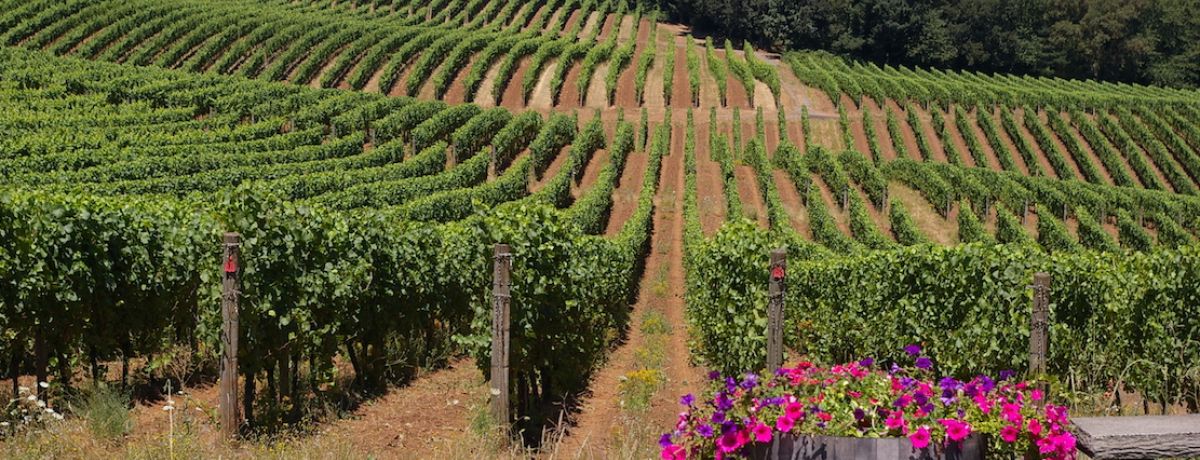Oregon

Oregon produces quite a small amount of wine but an awful lot of noise. Which is not at all to say that the state's wine industry is overrun by brash publicists – rather the reverse. Until the recent advent of some larger companies the typical Oregon wine operation consisted of relatively neat, high-trained vines round a few old wooden shacks manned by highly educated families revelling in the contrasts between their wine region and California. Wineries have tended to be small family affairs so winemaking equipment has therefore tended to be fairly homespun, with steel-lined open fruit boxes commonly used as fermentation vats for example. Small-batch winemaking predominates, and there are now over 900 wineries in the state, with more than 500 tasting rooms and almost 100 varieties of grapes grown.
The most obvious difference is the climate, which in Oregon can be distinctly cool and cloudy, especially in the Willamette (with the emphasis on the short A) Valley just south of Portland, where most of the wineries are clustered. The Willamette Valley is already being carved up into smaller appellations, so local are reputations here. As of early 2022 Oregon had a a total of 21 AVAs including in Williamette Valley nine sub-appellations: Dundee Hills, Eola-Amity Hills, McMinnville, Ribbon Ridge, Yamhill-Carlton, Chehalem Mountain, Van Duzer Corridor, and the two newest, Laurelwood and Tualatin Hills.
Wine producers like to follow the Burgundian model of growing their own grapes. Much is made locally of the fact that Oregon shares the 45th parallel with Bordeaux – although Burgundy would have been more convenient, given the determination with which Oregon wine producers have pursued the Holy Grail of Pinot Noir. Oregon’s AVAs see slightly less sunshine than many other wine regions which usefully lengthens the growing season. This is why Oregon’s predominant variety is the early-ripening Pinot Noir with the majority of it grown on rocky hillsides facing south or southeast above 200 feet. This is true of virtually all sites in Willamette Valley’s AVAs regardless of the weather pattern or soil type which are producing an increasing number of world-class Pinots, with Chardonnay gaining ground too. Oregon Chardonnay is increasingly popular and respected, especially now that there is greater understanding of individual clones and sites. Other increasingly widely planted varieties include Pinot Gris and Riesling along with Albariño, Gamay, Viognier and, in warmer parts of the state, Merlot, Cabernet Sauvignon, Cabernet Franc and Syrah.
The vine has spread south from the Willamette however to the drier Umpqua Valley, where the first Oregon vines were planted, and the much hotter Rogue Valley in Southern Oregon, a conveniently large AVA almost on the California border (though many miles from any California vineyards). There are also a few areas which are effectively extensions of Washington state wine regions.(The Rocks District of Milton-Freewater AVA is wholly contained within Washington and Oregon’s shared Walla Walla AVA, more often considered Washington wine country than Oregon wine country.) The southern part of the state, the Umpqua and Rogue Valleys are also warm enough to ripen even Cabernet vines consistently, although producers such as Abacela suggest that Tempranillo may have a future here. Basically, the further north you go in Oregon’s coastal vineyards just one mountain range in from the foggy coast, the more open it is to ocean influence, the cooler the vineyards and the more delicate the wines. In the south, summer drought can be a problem and irrigation is routine. In the north, rain at the wrong time is Willamette Valley’s lament.
For many years the perennial challenge for most Oregon wine producers was to persuade their grapes to ripen fully on the vine before the autumn rains arrive, bringing rot and spoiling the colour and flavours of the delicate Pinot Noir grape especially – but warmer summers increasingly prevail with heat stress and drought by no means unknown. So variable are the vintages here that the grape harvest may take place at any time from early September to November. Despite relatively high rainfall in such a high proportion of the state's vineyards, organic and biodynamic viticulture are more widespread in Oregon than in any other wine region of its size and the number of wine producers who understand true sustainability is admirable.
Such is the obvious quality of Oregon Pinot – world-class in an increasing number of instances – that other Burgundians have followed in the steps of the Drouhin family of Beaune who invested in the Willamette Valley as long ago as 1988. The California-based Jackson Family Wines international group of wine estates has been taking a particular interest in Oregon, as have some other Californians with less sustainable objectives.
Long-serving members of the Oregon wine community (and it is very much a community rather than an industry) include Adelsheim, Bethel Heights, The Eyrie Vineyards, Elk Cove, Knudsen, Ponzi, Sokol Blosser and Tualatin. Cristom is a noteworthy newcomer which makes a particularly fine Viognier as well as Pinots of distinction. Other superior producers include 00 Wines, Antica Terra, Brick House (biodynamic), Bergstrom, Evening Land, Hamacher, Rose and Arrow, Soter, and Walter Scott. All these and more are involved in a uniquely friendly annual winefest known as the International Pinot Noir Celebration at McMinnville in Yamhill county, just south of the Red Hills of Dundee, Oregon's most famous wine terroir.
There have been experiments with using Oregon oak for wine maturation and it seems unlikely that the idiosyncratic inhabitants of this characterful wine region will stop their quest for ever greater wine quality.
See Oregon Wine for more information on this region.